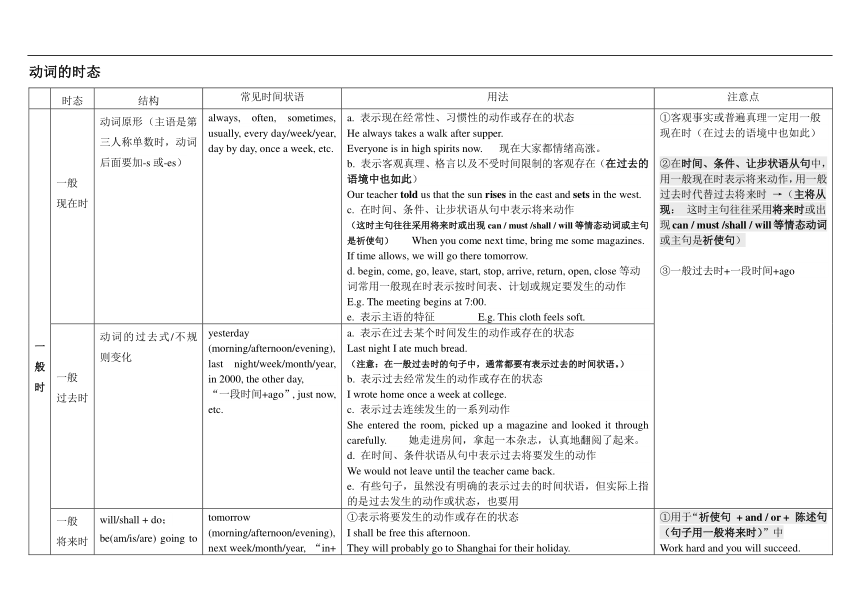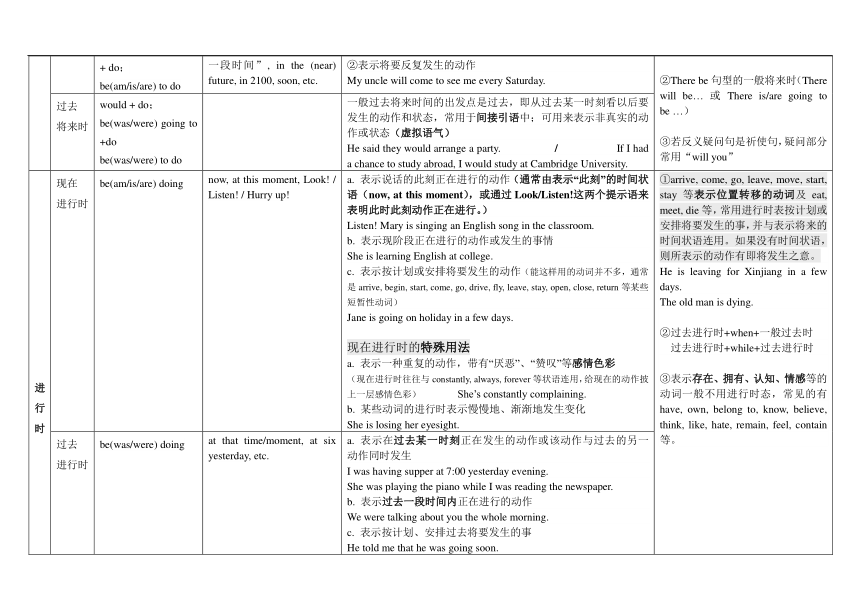2024届高考英语二轮复习动词的时态讲义
文档属性
| 名称 | 2024届高考英语二轮复习动词的时态讲义 |  | |
| 格式 | docx | ||
| 文件大小 | 28.0KB | ||
| 资源类型 | 教案 | ||
| 版本资源 | 通用版 | ||
| 科目 | 英语 | ||
| 更新时间 | 2024-02-26 10:03:13 | ||
图片预览


文档简介
动词的时态
时态 结构 常见时间状语 用法 注意点
一般时 一般 现在时 动词原形 (主语是第三人称单数时,动词后面要加-s或-es) always, often, sometimes, usually, every day/week/year, day by day, once a week, etc. a. 表示现在经常性、习惯性的动作或存在的状态
He always takes a walk after supper.
Everyone is in high spirits now. 现在大家都情绪高涨。
b. 表示客观真理、格言以及不受时间限制的客观存在(在过去的语境中也如此)
Our teacher told us that the sun rises in the east and sets in the west. c. 在时间、条件、让步状语从句中表示将来动作 (这时主句往往采用将来时或出现can / must /shall / will等情态动词或主句是祈使句) When you come next time, bring me some magazines.
If time allows, we will go there tomorrow. d. begin, come, go, leave, start, stop, arrive, return, open, close等动词常用一般现在时表示按时间表、计划或规定要发生的动作 E.g. The meeting begins at 7:00. e. 表示主语的特征 E.g. This cloth feels soft. ①客观事实或普遍真理一定用一般现在时(在过去的语境中也如此) ②在时间、条件、让步状语从句中,用一般现在时表示将来动作,用一般过去时代替过去将来时 →(主将从现: 这时主句往往采用将来时或出现can / must /shall / will等情态动词或主句是祈使句) ③一般过去时+一段时间+ago
一般 过去时 动词的过去式/不规则变化 yesterday (morning/afternoon/evening), last night/week/month/year, in 2000, the other day, “一段时间+ago”, just now, etc. a. 表示在过去某个时间发生的动作或存在的状态
Last night I ate much bread.
(注意:在一般过去时的句子中,通常都要有表示过去的时间状语。)
b. 表示过去经常发生的动作或存在的状态
I wrote home once a week at college. c. 表示过去连续发生的一系列动作
She entered the room, picked up a magazine and looked it through carefully. 她走进房间,拿起一本杂志,认真地翻阅了起来。
d. 在时间、条件状语从句中表示过去将要发生的动作
We would not leave until the teacher came back. e. 有些句子,虽然没有明确的表示过去的时间状语,但实际上指的是过去发生的动作或状态,也要用
一般 将来时 will/shall + do; be(am/is/are) going to + do; be(am/is/are) to do tomorrow (morning/afternoon/evening), next week/month/year, “in+一段时间”, in the (near) future, in 2100, soon, etc. ①表示将要发生的动作或存在的状态
I shall be free this afternoon.
They will probably go to Shanghai for their holiday.
②表示将要反复发生的动作
My uncle will come to see me every Saturday. ①用于“祈使句 + and / or + 陈述句(句子用一般将来时)”中 Work hard and you will succeed. ②There be句型的一般将来时(There will be… 或 There is/are going to be …) ③若反义疑问句是祈使句,疑问部分常用“will you”
过去 将来时 would + do; be(was/were) going to +do be(was/were) to do 一般过去将来时间的出发点是过去,即从过去某一时刻看以后要发生的动作和状态,常用于间接引语中;可用来表示非真实的动作或状态(虚拟语气)
He said they would arrange a party. / If I had a chance to study abroad, I would study at Cambridge University.
进行时 现在 进行时 be(am/is/are) doing now, at this moment, Look! / Listen! / Hurry up! a. 表示说话的此刻正在进行的动作(通常由表示“此刻”的时间状语(now, at this moment),或通过Look/Listen!这两个提示语来表明此时此刻动作正在进行。)
Listen! Mary is singing an English song in the classroom.
b. 表示现阶段正在进行的动作或发生的事情
She is learning English at college. c. 表示按计划或安排将要发生的动作(能这样用的动词并不多,通常是arrive, begin, start, come, go, drive, fly, leave, stay, open, close, return等某些短暂性动词) Jane is going on holiday in a few days. 现在进行时的特殊用法
a. 表示一种重复的动作,带有“厌恶”、“赞叹”等感彩
(现在进行时往往与constantly, always, forever等状语连用,给现在的动作披上一层感彩) She’s constantly complaining.
b. 某些动词的进行时表示慢慢地、渐渐地发生变化
She is losing her eyesight. ①arrive, come, go, leave, move, start, stay等表示位置转移的动词及eat, meet, die等,常用进行时表按计划或安排将要发生的事,并与表示将来的时间状语连用。如果没有时间状语,则所表示的动作有即将发生之意。
He is leaving for Xinjiang in a few days.
The old man is dying. ②过去进行时+when+一般过去时 过去进行时+while+过去进行时 ③表示存在、拥有、认知、情感等的动词一般不用进行时态,常见的有have, own, belong to, know, believe, think, like, hate, remain, feel, contain等。
过去 进行时 be(was/were) doing at that time/moment, at six yesterday, etc. a. 表示在过去某一时刻正在发生的动作或该动作与过去的另一动作同时发生
I was having supper at 7:00 yesterday evening.
She was playing the piano while I was reading the newspaper.
b. 表示过去一段时间内正在进行的动作
We were talking about you the whole morning.
c. 表示按计划、安排过去将要发生的事
He told me that he was going soon. 过去进行时的特殊用法
与always, constantly等词连用,表示感彩
The girl was always changing her mind.
将来 进行时 will/shall be doing this time tomorrow, at six tomorrow, etc. 表示在将来某一时间正在进行的动作
I’ll be cleaning my room this time tomorrow.
完成时 现在 完成时 have/has done already, yet, before, recently, lately, ever, since +时间点,for +一段时间,once, twice, (次数词), until now, up till now, so far, up to the moment(到目前为止)
over/in/during/for the past/last five years(在刚刚过去的5年里) ①表示结果的现在完成时
现在完成时着眼于过去的动作对现在产生的结果或影响。这是现在完成时的“已完成”用法,表示动作或过程发生在说话之前就已完成,并与现在有联系。这种联系实际上就是“过去的动作”对现在的影响或产生的结果。
I have bought a pen. (结果:I have a pen now.)
②表示经历的现在完成时
强调过去某一时刻到说话时这段时间中的经历。
I have visited Beijing at least ten times.
③表示延续的现在完成时
这是现在完成时的“未完成”用法,表示一个动作或状态从过去某时开始,持续到现在,而且有可能要继续下去。
I have lived here for more than thirty years. ①主句(现在完成时) + since + 从句(一般过去时) ②It is / has been + 一段时间+ since + 从句(一般过去时) (自从…以来,已有…年了。) E.g. It is two years since I moved here. ③“It/This is + the +序数词+ time + that…”句式中,that后的从句用现在完成时 E.g. This is the first time that I have visited the city. ④have gone to (去了未回) have been to (去了已回) have been in (表“已在某地待了多久”) ⑤过去完成时+when+一般过去时
过去 完成时 had done 常用by引导的时间状语(e.g. by last week, by the time + 句子(过去时))或以before, until, when, than等词引导的内含一般过去时的时间状语从句(e.g. before + 句子(过去时)) ①“已完成”用法
表示某一动作或状态在过去某一时间之前或过去某一动作之前已经完成。句中常用by引导的时间状语或以before, until, when, than等词引导的内含一般过去时的时间状语从句。
By 5:00 yesterday morning we had done that work.
He had left when we got to the station. ② “想象性”用法(虚拟语气)
过去完成时有时表示一种未实现的愿望或想法,主要用在if引导的和过去事实相反的条件句以及wish, as if引导的从句中。
If she had worked hard, she would have succeeded.
The two strangers talked as if they had been good friends for many years.
③表示“刚刚……就……”
过去完成时常用在hardly/scarcely/barely ... when...; no sooner ... than ...等结构中,表示“刚刚……就……”。
Hardly had he begun to speak when the audience interrupted him. 提示:intend, mean, hope, want, plan, suppose, expect, think等动词的过去完成时可以用来表示一个本来打算做而未做的事。
I had meant to come, but something happened. 我原本打算来的,但有事发生了。
将来 完成时 will/shall have done We shall have learned 12 units by the end of this term.
By the time you get home I will have cleaned the house from top to bottom. ①表示在将来某一时间之前已完成的动作,并往往对将来某一时间产生影响。
We shall have learned 12 units by the end of this term. / By the time you get home I will have cleaned the house from top to bottom. ②表示推测
I am sure he will have got the information.
完成进行时 现在完成进行时 have/has been doing 常和all this time, this week, this month, all night, all the morning, recently等状语以及since和for引导的状语连用 ①表示动作从过去某时开始,一直延续到现在,而且会继续进行下去
现在完成进行时常和all this time, this week, this month, all night, all the morning, recently等状语以及since和for引导的状语连用。
She has been reciting the words all the morning.
②表示动作刚刚结束
My clothes are all wet. I've been working in the rain.
③表示到目前为止的一段时间里一直反复进行的动作
You’ve been saying that for five years. 这话你已经说了五年了。
④表达较重的感彩
Too much has been happening today. 今天可真是个多事的日子。 现在完成进行时和现在完成时的比较
①现在完成进行时可以表示动作的重复,而现在完成时一般不表示重复性。
Have you been meeting him recently 你最近常和他见面吗?
Have you met him recently 你最近见到过他吗?
②现在完成进行时有时含有感彩,而现在完成时一般是平铺直叙。
I have been waiting for you for two hours. (可能表示不满) I have waited for you for two hours. (说明一个事实)
过去完成进行时 had been doing ①表示过去某一时间之前一直进行的动作
过去完成进行时表示动作在过去某一时间之前开始,一直延续到这一过去时间。和过去完成时一样,过去完成进行时也必须以一过去时间为前提。I had been looking for it for days before I found it. ②表示反复的动作
He had been mentioning your name to me. 他过去多次向我提到过你的名字。 ③过去完成进行时还常用于间接引语中 I asked where they had been staying all those days. 我问他们那些天是待在哪儿的。
时态 结构 常见时间状语 用法 注意点
一般时 一般 现在时 动词原形 (主语是第三人称单数时,动词后面要加-s或-es) always, often, sometimes, usually, every day/week/year, day by day, once a week, etc. a. 表示现在经常性、习惯性的动作或存在的状态
He always takes a walk after supper.
Everyone is in high spirits now. 现在大家都情绪高涨。
b. 表示客观真理、格言以及不受时间限制的客观存在(在过去的语境中也如此)
Our teacher told us that the sun rises in the east and sets in the west. c. 在时间、条件、让步状语从句中表示将来动作 (这时主句往往采用将来时或出现can / must /shall / will等情态动词或主句是祈使句) When you come next time, bring me some magazines.
If time allows, we will go there tomorrow. d. begin, come, go, leave, start, stop, arrive, return, open, close等动词常用一般现在时表示按时间表、计划或规定要发生的动作 E.g. The meeting begins at 7:00. e. 表示主语的特征 E.g. This cloth feels soft. ①客观事实或普遍真理一定用一般现在时(在过去的语境中也如此) ②在时间、条件、让步状语从句中,用一般现在时表示将来动作,用一般过去时代替过去将来时 →(主将从现: 这时主句往往采用将来时或出现can / must /shall / will等情态动词或主句是祈使句) ③一般过去时+一段时间+ago
一般 过去时 动词的过去式/不规则变化 yesterday (morning/afternoon/evening), last night/week/month/year, in 2000, the other day, “一段时间+ago”, just now, etc. a. 表示在过去某个时间发生的动作或存在的状态
Last night I ate much bread.
(注意:在一般过去时的句子中,通常都要有表示过去的时间状语。)
b. 表示过去经常发生的动作或存在的状态
I wrote home once a week at college. c. 表示过去连续发生的一系列动作
She entered the room, picked up a magazine and looked it through carefully. 她走进房间,拿起一本杂志,认真地翻阅了起来。
d. 在时间、条件状语从句中表示过去将要发生的动作
We would not leave until the teacher came back. e. 有些句子,虽然没有明确的表示过去的时间状语,但实际上指的是过去发生的动作或状态,也要用
一般 将来时 will/shall + do; be(am/is/are) going to + do; be(am/is/are) to do tomorrow (morning/afternoon/evening), next week/month/year, “in+一段时间”, in the (near) future, in 2100, soon, etc. ①表示将要发生的动作或存在的状态
I shall be free this afternoon.
They will probably go to Shanghai for their holiday.
②表示将要反复发生的动作
My uncle will come to see me every Saturday. ①用于“祈使句 + and / or + 陈述句(句子用一般将来时)”中 Work hard and you will succeed. ②There be句型的一般将来时(There will be… 或 There is/are going to be …) ③若反义疑问句是祈使句,疑问部分常用“will you”
过去 将来时 would + do; be(was/were) going to +do be(was/were) to do 一般过去将来时间的出发点是过去,即从过去某一时刻看以后要发生的动作和状态,常用于间接引语中;可用来表示非真实的动作或状态(虚拟语气)
He said they would arrange a party. / If I had a chance to study abroad, I would study at Cambridge University.
进行时 现在 进行时 be(am/is/are) doing now, at this moment, Look! / Listen! / Hurry up! a. 表示说话的此刻正在进行的动作(通常由表示“此刻”的时间状语(now, at this moment),或通过Look/Listen!这两个提示语来表明此时此刻动作正在进行。)
Listen! Mary is singing an English song in the classroom.
b. 表示现阶段正在进行的动作或发生的事情
She is learning English at college. c. 表示按计划或安排将要发生的动作(能这样用的动词并不多,通常是arrive, begin, start, come, go, drive, fly, leave, stay, open, close, return等某些短暂性动词) Jane is going on holiday in a few days. 现在进行时的特殊用法
a. 表示一种重复的动作,带有“厌恶”、“赞叹”等感彩
(现在进行时往往与constantly, always, forever等状语连用,给现在的动作披上一层感彩) She’s constantly complaining.
b. 某些动词的进行时表示慢慢地、渐渐地发生变化
She is losing her eyesight. ①arrive, come, go, leave, move, start, stay等表示位置转移的动词及eat, meet, die等,常用进行时表按计划或安排将要发生的事,并与表示将来的时间状语连用。如果没有时间状语,则所表示的动作有即将发生之意。
He is leaving for Xinjiang in a few days.
The old man is dying. ②过去进行时+when+一般过去时 过去进行时+while+过去进行时 ③表示存在、拥有、认知、情感等的动词一般不用进行时态,常见的有have, own, belong to, know, believe, think, like, hate, remain, feel, contain等。
过去 进行时 be(was/were) doing at that time/moment, at six yesterday, etc. a. 表示在过去某一时刻正在发生的动作或该动作与过去的另一动作同时发生
I was having supper at 7:00 yesterday evening.
She was playing the piano while I was reading the newspaper.
b. 表示过去一段时间内正在进行的动作
We were talking about you the whole morning.
c. 表示按计划、安排过去将要发生的事
He told me that he was going soon. 过去进行时的特殊用法
与always, constantly等词连用,表示感彩
The girl was always changing her mind.
将来 进行时 will/shall be doing this time tomorrow, at six tomorrow, etc. 表示在将来某一时间正在进行的动作
I’ll be cleaning my room this time tomorrow.
完成时 现在 完成时 have/has done already, yet, before, recently, lately, ever, since +时间点,for +一段时间,once, twice, (次数词), until now, up till now, so far, up to the moment(到目前为止)
over/in/during/for the past/last five years(在刚刚过去的5年里) ①表示结果的现在完成时
现在完成时着眼于过去的动作对现在产生的结果或影响。这是现在完成时的“已完成”用法,表示动作或过程发生在说话之前就已完成,并与现在有联系。这种联系实际上就是“过去的动作”对现在的影响或产生的结果。
I have bought a pen. (结果:I have a pen now.)
②表示经历的现在完成时
强调过去某一时刻到说话时这段时间中的经历。
I have visited Beijing at least ten times.
③表示延续的现在完成时
这是现在完成时的“未完成”用法,表示一个动作或状态从过去某时开始,持续到现在,而且有可能要继续下去。
I have lived here for more than thirty years. ①主句(现在完成时) + since + 从句(一般过去时) ②It is / has been + 一段时间+ since + 从句(一般过去时) (自从…以来,已有…年了。) E.g. It is two years since I moved here. ③“It/This is + the +序数词+ time + that…”句式中,that后的从句用现在完成时 E.g. This is the first time that I have visited the city. ④have gone to (去了未回) have been to (去了已回) have been in (表“已在某地待了多久”) ⑤过去完成时+when+一般过去时
过去 完成时 had done 常用by引导的时间状语(e.g. by last week, by the time + 句子(过去时))或以before, until, when, than等词引导的内含一般过去时的时间状语从句(e.g. before + 句子(过去时)) ①“已完成”用法
表示某一动作或状态在过去某一时间之前或过去某一动作之前已经完成。句中常用by引导的时间状语或以before, until, when, than等词引导的内含一般过去时的时间状语从句。
By 5:00 yesterday morning we had done that work.
He had left when we got to the station. ② “想象性”用法(虚拟语气)
过去完成时有时表示一种未实现的愿望或想法,主要用在if引导的和过去事实相反的条件句以及wish, as if引导的从句中。
If she had worked hard, she would have succeeded.
The two strangers talked as if they had been good friends for many years.
③表示“刚刚……就……”
过去完成时常用在hardly/scarcely/barely ... when...; no sooner ... than ...等结构中,表示“刚刚……就……”。
Hardly had he begun to speak when the audience interrupted him. 提示:intend, mean, hope, want, plan, suppose, expect, think等动词的过去完成时可以用来表示一个本来打算做而未做的事。
I had meant to come, but something happened. 我原本打算来的,但有事发生了。
将来 完成时 will/shall have done We shall have learned 12 units by the end of this term.
By the time you get home I will have cleaned the house from top to bottom. ①表示在将来某一时间之前已完成的动作,并往往对将来某一时间产生影响。
We shall have learned 12 units by the end of this term. / By the time you get home I will have cleaned the house from top to bottom. ②表示推测
I am sure he will have got the information.
完成进行时 现在完成进行时 have/has been doing 常和all this time, this week, this month, all night, all the morning, recently等状语以及since和for引导的状语连用 ①表示动作从过去某时开始,一直延续到现在,而且会继续进行下去
现在完成进行时常和all this time, this week, this month, all night, all the morning, recently等状语以及since和for引导的状语连用。
She has been reciting the words all the morning.
②表示动作刚刚结束
My clothes are all wet. I've been working in the rain.
③表示到目前为止的一段时间里一直反复进行的动作
You’ve been saying that for five years. 这话你已经说了五年了。
④表达较重的感彩
Too much has been happening today. 今天可真是个多事的日子。 现在完成进行时和现在完成时的比较
①现在完成进行时可以表示动作的重复,而现在完成时一般不表示重复性。
Have you been meeting him recently 你最近常和他见面吗?
Have you met him recently 你最近见到过他吗?
②现在完成进行时有时含有感彩,而现在完成时一般是平铺直叙。
I have been waiting for you for two hours. (可能表示不满) I have waited for you for two hours. (说明一个事实)
过去完成进行时 had been doing ①表示过去某一时间之前一直进行的动作
过去完成进行时表示动作在过去某一时间之前开始,一直延续到这一过去时间。和过去完成时一样,过去完成进行时也必须以一过去时间为前提。I had been looking for it for days before I found it. ②表示反复的动作
He had been mentioning your name to me. 他过去多次向我提到过你的名字。 ③过去完成进行时还常用于间接引语中 I asked where they had been staying all those days. 我问他们那些天是待在哪儿的。
